The Chinese dragon (lóng; 龙) is one of the most recognizable emblems of any culture in world history, and it has enjoyed a long, rich tradition. In this paper, the depiction of the dragon in Chinese art will be explored. The mythological creature’s origin and evolution will be discussed in order to give the reader a better understanding of its place in Chinese tradition and ceremony. Finally, works representative of various time periods and mediums will be presented and analyzed.
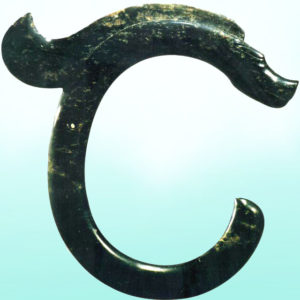
The origin of the dragon myth in China is unclear, but several competing theories have been put forth by scholars. The nāga in Hindu and Buddhist mythology were cobra-like benevolent demi-gods said to inhabit bodies of water and to hold mystical power over the weather. The shape-shifting nāga were able to transform parts or all of their bodies to appear human and were often depicted in serpent-man form in Indian painting and sculpture. They were thought to control the rain and received appeal from worshippers in times of drought. Buddhist literature and art depicting the nāga imported from India may have been responsible in part for the origin of the dragon myth in China (Visser 1-6).
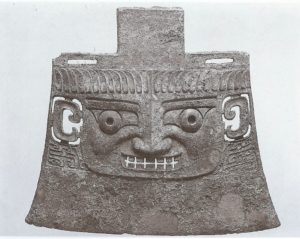
Second, references to the discovery of “dragon bones” and their use in herbal remedies can be found in ancient Chinese literature. It is entirely plausible that fossilized dinosaur bones were discovered and rightly assumed to have belonged to very large reptilian creatures. There are numerous species of dinosaurs that have similar anatomy to the dragons depicted in ancient Chinese art (Visser 90-96). Third, the Chinese dragon may have emerged from the deification of extant animals such as the saltwater crocodile or other large aquatic reptiles that were contemporary with the region’s earliest inhabitants. While each theory has merit, perhaps the origin of the Chinese dragon myth is best understood as a combination of these factors rather than arising from a single source.
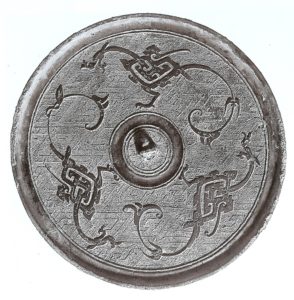
The dragon myth of China in its earliest form shared many common characteristics with the nāga of India, including the dragon’s ability to take the form of any other living being. Likewise, the dragon of Chinese folklore maintained its dominion over the entire water cycle as its nāga predecessor; some literary sources even suggest that the mere presence of a dragon in a piece of art predicates the existence of water in the piece. The dragon’s mastery over the aquatic also helps explain why dragon-boats were considered safe and worthy vessels to carry the emperor and high-ranking nobleman in this life and the next. Given the dragon’s supposed dominion over the water cycle and weather patterns (and hence the giver of rain for life to the land and crops to feed the people), it should not be surprising that alleged sightings of the mythological creature under the right circumstances were treated as an omen of good fortune. However, catastrophic weather conditions were thought to be caused by dragons fighting one another (Visser 41-46).

The earliest known examples of dragon-like motifs in Chinese art date back as far as the fourth millennia B.C.E. (Wu 197). The jade “pig-dragon” (zhūlóng; 玉猪龙) totems of Hongshan culture (Hóngshān wénhuà; 红山文化) were more akin to common snakes in appearance than what eventually evolved to be the Chinese dragon, but one can still see the beginnings of styles that would persist in future depictions of the mythological creature (Childs-Johnson 82). The totems are highly stylized and lack the limbs associated with more complex amalgamations prevalent in later works. This motif continued on into the late Shang Dynasty and beyond with the emergence of a hooked “c” kui (kuí; 葵) dragon pattern (Lee 35).
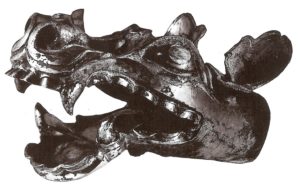
Starting in the Zhou Dynasty, we begin to see more variation in dragon representations as the mythology surrounding the creatures became increasingly popular. Limbs began to appear in some depictions, breaking from the original “pig-dragon” totems (Lee 50, Ho 171). The dragon’s head became less serpentine and more crocodilian in form, with a large gaping mouth, a full set of teeth, and flaring nostrils. Of further note is the emergence of external auditory anatomy, whereas such structures are absent from all reptiles (Lee 48).
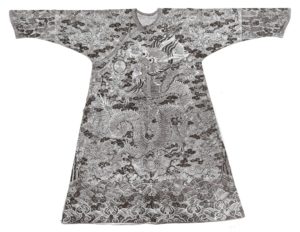 Whatever the origin of the dragon totem, there is little dispute that the dragon quickly became the most popular symbol in Chinese mythology. Just as the lion came to symbolize the British Empire, the dragon came to represent the imperial house of the ruling Chinese dynasty. Early Chinese literature suggests that at least some imperial garments included embroidered dragons as early as the 27th century B.C.E. (Visser 39, Lee 475). During the Zhou Dynasty, it was codified into law that depictions of dragons with five toes were for imperial representation only, while four-toed dragons were reserved for nobles, and three-toed dragons used only for commoners. The founde of the Western Han Dynasty, Liu Bang (c. 206-195 B.C.E.), is the first known emperor to claim lineage from a dragon. Ever since, the dragon has been the official symbol of Chinese imperial power (Wu 197). It was thereafter considered a bad omen for a live dragon to be sighted in less than auspicious circumstances, such as the dwelling of a commoner (Visser 55-56). One need only visit one of China’s imperial palaces and see the opulent furniture and stone relief sculpture depicting dragons to understand the importance of the myth to China’s ruling class (Lee 477). Even so, representations of dragons on utilitarian vessels such as porcelain storage containers used by the middle and lower classes was also common (Lee 452).
Whatever the origin of the dragon totem, there is little dispute that the dragon quickly became the most popular symbol in Chinese mythology. Just as the lion came to symbolize the British Empire, the dragon came to represent the imperial house of the ruling Chinese dynasty. Early Chinese literature suggests that at least some imperial garments included embroidered dragons as early as the 27th century B.C.E. (Visser 39, Lee 475). During the Zhou Dynasty, it was codified into law that depictions of dragons with five toes were for imperial representation only, while four-toed dragons were reserved for nobles, and three-toed dragons used only for commoners. The founde of the Western Han Dynasty, Liu Bang (c. 206-195 B.C.E.), is the first known emperor to claim lineage from a dragon. Ever since, the dragon has been the official symbol of Chinese imperial power (Wu 197). It was thereafter considered a bad omen for a live dragon to be sighted in less than auspicious circumstances, such as the dwelling of a commoner (Visser 55-56). One need only visit one of China’s imperial palaces and see the opulent furniture and stone relief sculpture depicting dragons to understand the importance of the myth to China’s ruling class (Lee 477). Even so, representations of dragons on utilitarian vessels such as porcelain storage containers used by the middle and lower classes was also common (Lee 452).
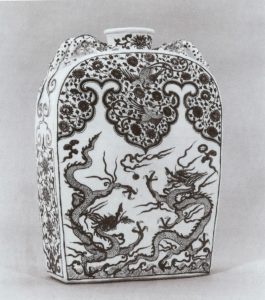 Visser compiles various Han Dynasty texts that describe how a dragon should be depicted. By this time, the dragon’s canonized form had grown far more complex in the three to four thousand years since the early “pig-dragon” examples of the Hongshan culture:
Visser compiles various Han Dynasty texts that describe how a dragon should be depicted. By this time, the dragon’s canonized form had grown far more complex in the three to four thousand years since the early “pig-dragon” examples of the Hongshan culture:
The people paint the dragon’s shape with a horse’s head and a snake’s tail. Further, there are expressions as ‘three joints’ and ‘nine resemblances’ (of the dragon), to wit: from head to shoulder, from shoulder to breast, from breast to tail. These are the joints; as to the nine resemblances, they are the following: his horns resemble those of a stag, his head that of a camel, his eyes those of a demon, his neck that of a snake, his belly that of a clam … , his scales those of a carp, his claws those of an eagle, his soles those of a tiger, his ears those of a cow. … [T]he dragon’s 81 scales form a number consisting of nine times nine. Nine is Yang. The carp’s 36 scales form a number consisting of six times six. Six is Yin. … The dragon has five fingers. … [A] dragon has whiskers at the sides of his mouth and a bright pearl under his chin; under his throat he has scales lying in a reversed direction; upon his head he has a broad eminence called in writing ch’ih muh; if a dragon has no ch’ih muh, he cannot ascend to the sky. His break turns into clouds, and then can change into water and into fire (rain and lightning) (Visser 70-71).
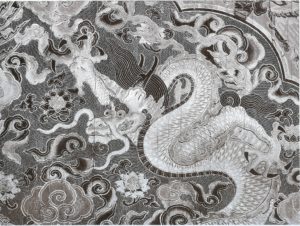
Visser goes on to describe the variations between different depictions of dragons based on their age, sex, and primary dwelling. In only rare cases are dragons shown as having wings as their power of flight was thought to be mystical rather than born of any kind of anatomical structure. There is also a detailed formula for determining a dragon’s correct color, according to Chinese folklore (Visser 72-81).
Among the most famous Chinese works depicting dragons during the medieval period in China is a wall scroll entitled Nine Dragons (jiǔlóngtú; 九龙图) by Chen Rong (ChénRóng; 陈容), an impoverished scholar of the Southern Song Dynasty. The black ink scroll measures over 10 meters long and includes a poem written by the artist. In the poem, Chen Rong recounts that he created the masterpiece while intoxicated, and further boasts:
I have painted the picture of nine dragons, and the greatness that emerged from the tip of my brush cannot be found elsewhere in the world. At a distance, one feels as if the clouds and the waves were flying and moving. Viewed closely, one suspects that only god could have painted these dragons (Wu 197-199).
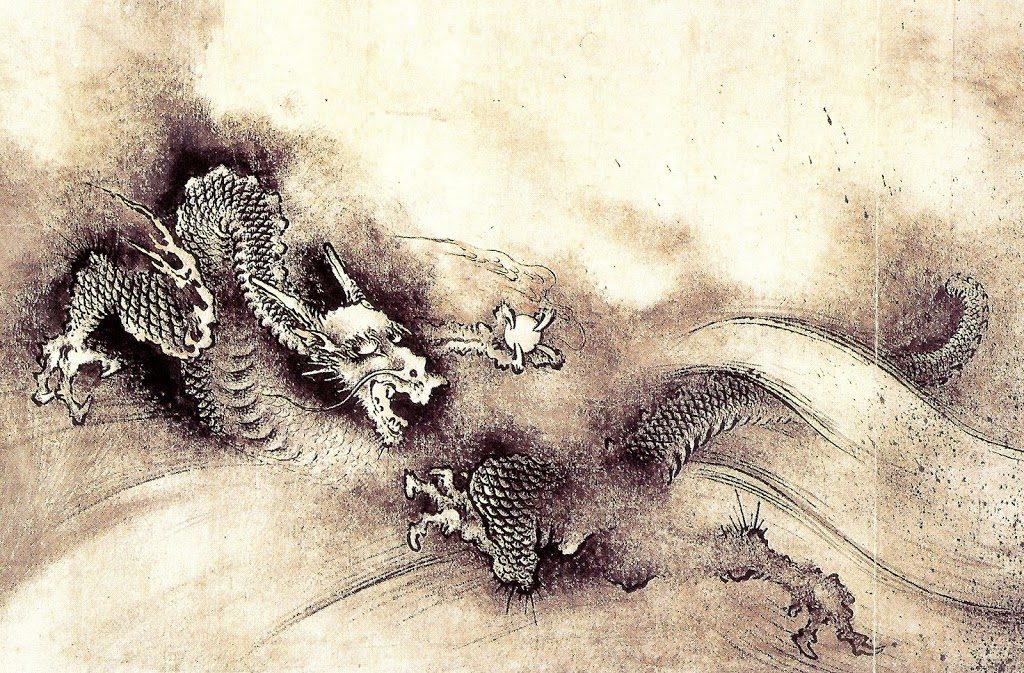
The work is indeed magnificent in technique and monumental in scale. Its style most closely resembles the lyric mode of Southern Song painting with its contrast of harsh black lines of the dragons juxtaposed against the flowing wet ink technique of the surrounding mist. Each dragon emphasizes different attributes of the dragon, but all have a dynamic energy and mystical quality. The detail of one of the nine dragons depicted below clutches a sphere which most likely represents a pearl, a symbol of great wealth and/or wisdom (Visser 103-108, Wu 199). As this piece demonstrates, there was very little morphological change of the Chinese dragon creature from the time of the canonization of its form during the Han Dynasty. While the anatomy of the Chinese dragon did not change, new techniques and technologies enabled artists to create innovative works based on the age-old legends of the creature.
From its humble beginnings as a serpent totem, the Chinese dragon eventually came to ubiquitously symbolize good fortune, wisdom, and power. They were largely considered benevolent creatures, yet dangerous if crossed. Visser cites an apt example of the reverence afforded the dragon, attributed to Song Dynasty scholar Liu Dian (LiùDiàn; 陆佃): “[N]one of the animals is so wise as the dragon. His blessing power is not a false one. He can be smaller than small, bigger than big, higher than high, and lower than low” (Visser 66). To this day, identifying someone as a “dragon” in China is a great compliment and implicitly prophetic insofar as the person lives up to the auspicious designation. Although other Far East and Southeast Asian civilizations also share mythological traditions involving the dragon, the Chinese lay unique claim to it as the enduring symbol of their culture.
Works Cited
Childs-Johnson, Elizabeth. “Jades of the Hongshan culture: The dragon and fertility cult worship.” Arts Asiatiques 46 (1991): 82-95. Print.
Ho, Chao Hsi, Li-Chun Huang, and Pen-Yi Chang. “Studying from the Bronze Ware of Change of Dragon Patterns to Authenticate the Pre-Chin Dynasty Design Aesthetic Proposition.” International Journal of the Humanities 7.3 (2009): 165-78. Print.
Lee, Sherman E. A History of Far Eastern Art. Ed. Naomi Noble Richard. 5th ed. Upper Saddle River: Prentice Hall, 1994. Print.
Visser, Marinus Willem de. The Dragon in China and Japan. Nachdr. d. Ausg. ed. Kessinger: Whitefish, Mt., 2009. Print.
Wu, Tung. Tales from the Land of Dragons: 1000 Years of Chinese Painting. Boston: Museum of Fine Arts, 1997. Print.